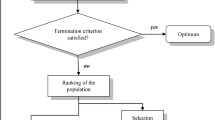Abstract
The genetic algorithm BIANCA, developed for design and optimisation of composite laminates, is a multi-population genetic algorithm, capable to deal with unconstrained and constrained hard combinatorial optimisation problems in engineering. The effectiveness and robustness of BIANCA rely on the great generality and richness in the representation of the information, i.e. the structure of populations and individuals in BIANCA, and on the way the information is extensively exploited during genetic operations. Moreover, we developed proper and original strategies to treat constrained optimisation problems through the generalisation of penalisation methods. BIANCA can also treat constrained multi-objective problems based on the construction of the Pareto frontier. Therefore, BIANCA allows us to approach very general design problems for composite laminates, but also to make a step forward to the treatment of more general problems of optimisation of materials and structures. In this paper, we describe specifically the case of optimal design of composite laminates, concerning both the theoretical formulation and the numeric resolution.
Similar content being viewed by others
References
Haftka R.T., Gürdal Z.: Elements of structural optimization. Springer, Berlin (1992)
Arora J.: Optimization of structural and mechanical systems. World Scientific, Singapore (2007)
Deb K.: Multi-objective optimization using evolutionary algorithms. Wiley, London (2001)
Goldberg D.: Genetic algorithms in search, optimization, and machine learning. Addison and Wesley, Reading (1989)
Michalewicz Z.: Genetic algorithms + data structures = evolution programs. Spinger, Berlin (1996)
Gürdal Z., Haftka R.T., Hajela P.: Design and optimization of laminated composite materials. Wiley, London (1999)
Vincenti, A.: Conception et optimisation de composites par méthode polaire et algorithmes génétiques. PhD Thesis, Université de Bourgogne, ISAT, 2002 (in French)
Vincenti, A., Vannucci, P., Verchery, G.: Design of composite laminates as an optimization problem: a new genetic algorithm approach based upon tensor invariants. In: Proceedings of WCSMO 5 (5th World Congress on Structural and Multidisciplinary Optimization). Lido di Jesolo-Venice, Italy, 19th–23th May 2003
Vannucci P.: Designing the elastic properties of laminates as an optimisation problem: a unified approach based on polar tensor invariants. Struct. Multidiscip. Optim. 31(5), 378–387 (2006)
Deb K.: An efficient constraint handling method for genetic algorithms. Comput. Methods Appl. Mech. Eng. 186, 311–338 (2000)
Coello Coello C.A.: Theoretical and numerical constraint handling techniques used with evolutionary strategies: a survey of the state of the art. Comput. Methods. Appl. Mech. Eng. 191, 1245–1287 (2002)
Landa Becerra R., Coello Coello C.A.: Cultured differential evolution for constrained optimization. Comput. Methods. Appl. Mech. Eng. 195, 4303–4322 (2006)
Santana-Quintero, L. V., Hernàndez-Dìaz, A.G., Molina, J., Coello Coello, C.A.: DEMORS: a hybrid multi-objective algorithm using differential evolution and rough set theory for constrained problems. Comput. Oper. Res. (in press) (2009)
Habbal A., Petersson J., Thellner M.: Multidisciplinary topology optimization solved as a Nash game. Int. J. Numer. Methods. Eng. 61, 949–963 (2004)
Deb K.: Introduction to evolutionary multiobjective optimization. Lect. Notes. Comput. Sci. 5252, 59–96 (2008)
Marco, N., Desideri, J.A., Lanteri, S.: Multi-objective optimization in CFD by genetic algorithms. INRIA reports no. 3686 (1999)
Ahmadian, M.R.: A general strategy for the optimal design of laminated composites by the polar-genetic method. PhD thesis, Université de Versailles (2007)
Vincenti, A., Ahmadian, M.R., Vannucci, P.: A general strategy for the optimal design of laminated composites by the polar-genetic method. Int. J. Mech. Sci., (Submitted) (2009)
Park W.J.: An optimal design of simple symmetric laminates under the first ply failure. J. Compos. Mater. 16, 341–355 (1982)
Vannucci P.: ALE-PSO: an adaptive swarm algorithm to solve design problems of laminates. Algorithms 2, 710–734 (2009). doi:10.3390/a2020710
Pardalos P.M., Resende M.G.C.: Handbook of applied optimization. Oxford University Press, Oxford (2002)
Hirsch M.J., Meneses C.N., Pardalos P.M., Resende M.G.C.: Global optimization by continuous grasp. Optim. Lett. 1(2), 201–212 (2007)
Hirsch M.J., Pardalos P.M., Resende M.G.C.: Solving systems of nonlinear equations with continuous grasp. Nonlinear Anal. Real World Appl. 10(4), 2000–2006 (2009)
Author information
Authors and Affiliations
Corresponding author
Rights and permissions
About this article
Cite this article
Vincenti, A., Ahmadian, M.R. & Vannucci, P. BIANCA: a genetic algorithm to solve hard combinatorial optimisation problems in engineering. J Glob Optim 48, 399–421 (2010). https://doi.org/10.1007/s10898-009-9503-2
Received:
Accepted:
Published:
Issue Date:
DOI: https://doi.org/10.1007/s10898-009-9503-2




